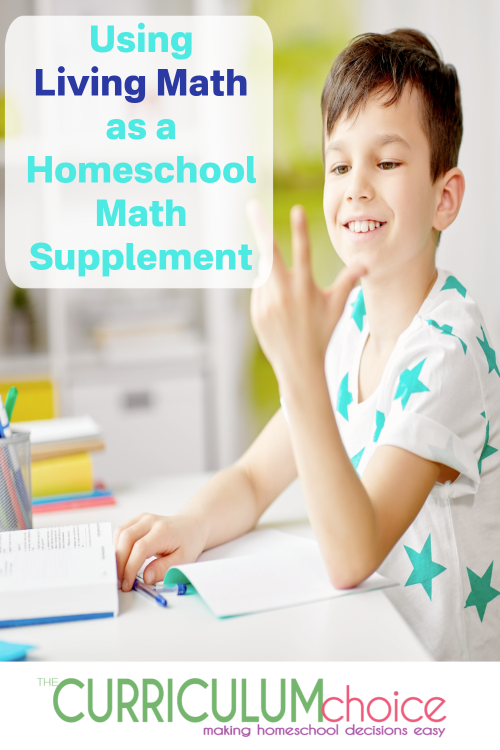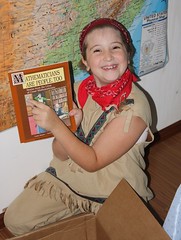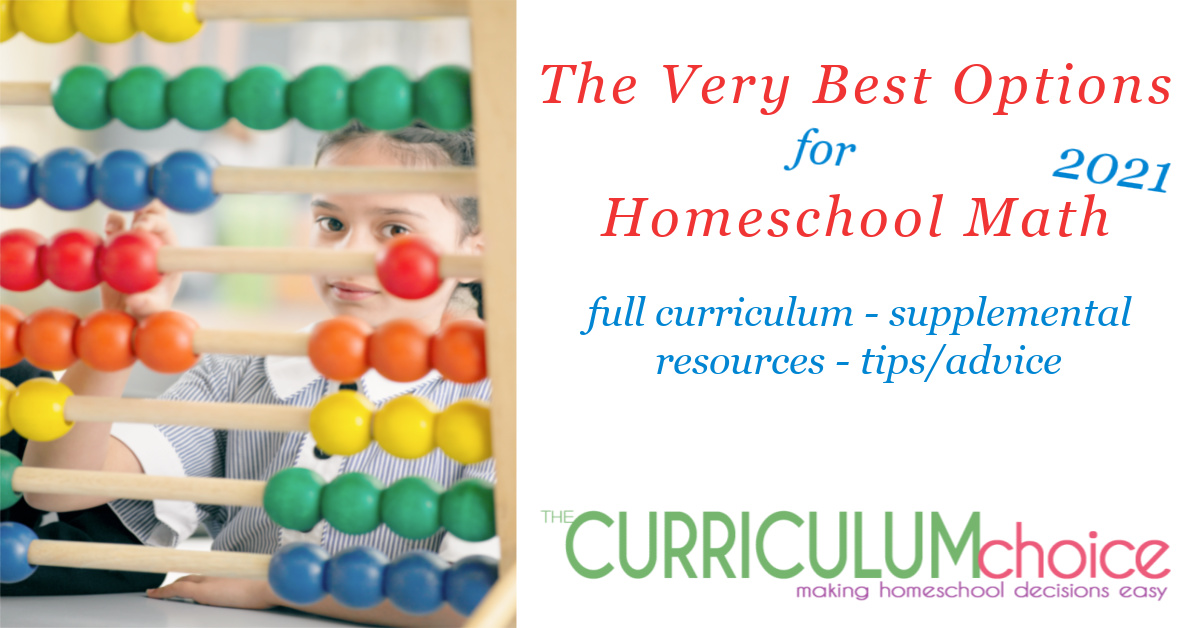This Living Math Curriculum focuses on integrating math into other subjects, so Living Math often crosses over into art, history, and science. Let’s talk specifically about how to use living math as a homeschool math supplement.

Using Living Math Curriculum as a Homeschool Math Supplement
Living Math is a curriculum written by Julie Brennan, a professional CPA, a mom of four, and an obvious math lover. If you have heard of living math, you may think that this curriculum is full of hands-on games and puzzles with lots of living math books.
Actually it is more of a historical tour through time, looking at the mathematical developments of each period. Living books are the cornerstone of this curriculum although there are some puzzles and activities sprinkled among the readings.
For example, you study Thales, the Greek Mathematician who was fascinated by pyramids and then do a hands-on pyramid measuring activity. These activities are not enough for a thorough math curriculum. In addition to the historical perspective Julie offers, you will still need to add the study of math facts taught through a skills or games based learning option. From what I’ve read most families use Living Math as a supplement to their existing math programs and textbooks. There is a deliberate focus on integrating math into other subjects, so Living Math often crosses over into art, history, and science.
You can purchase the electronic materials online via Paypal, and Julie sends you links where you can download all the PDF outlines and activity pages.
The Living Math Curriculum is broken into four units which are offered at three levels:
- Primary – Designed for lower elementary grades, approximately ages 6 to 9.
- Intermediate – Designed for upper elementary grades, approximately ages 9 to 12.
- Advanced – This is a dual level, with resources for 13 and up, and a High School/Adult section in each lesson plan for more challenging reading and exploration.
This is the outline for the four chronological units available:
- Unit 1: Ancients and World Cultures
- Unit 2: The Alexandrians and Medieval Math
- Unit 3: Renaissance to Enlightenment
- Unit 4: The Modern Age of Mathematics

Living Math is a perfect fit for Charlotte Mason homeschoolers. You can add the mathematicians to your timeline, use real world problems to recreate what they discovered, and document it in a math notebook.
The Living Math units are not “open and go” curriculum. There are no schedules or boxes to check. It is more of an outline. Specific pages or chapters in each suggested book are listed clearly but you will not find a day by day schedule. For a math-challenged mom who is totally new to this style of learning math, there is some advanced preparation. Personally, I have to read over the lesson and mark the resources that I have on hand, preview them, and then try to schedule them. I also discovered that many of the activities are much harder than I anticipated. These are problem solving activities, often not the clear-cut “right and wrong” types of math I did in school. For example, we built a tower from straws and tape. Some of the activities and books have no answer keys, so if you don’t solve the problem, it can be a bit frustrating. To cope with this ambiguity, I’ve learned to approach the activities more as a time of fun exploration rather than a problem to solve.
According to the lessons themselves, “the pacing of the course is completely up to you. Much of the material in each lesson plan can be covered in two weeks.” So estimating two weeks per lesson, a unit should last about 16 weeks. In my experience, I would agree that two weeks per lesson is about right.
So, to make it more concise, for $20 you are getting reading lists, teaching notes, and some activities/handouts that can be used to supplement your existing math curriculum for approximately 16 weeks. Living Math is not a complete math curriculum but a study of math history through the ages using living books (which you purchase or borrow on your own).
My Thoughts On Living Math Curriculum as a Homeschool Math Supplement
After using this material for about one semester, I do have some evaluations. If there were one or two unifying spines holding this curriculum together, I think Living Math would be more coherent. Because I don’t have the benefit of a strong math history foundation myself, I have to rely on the scattered chapters to do the teaching. In other words, I can’t draw up information from my own memory to teach about Pythagoras or Galileo. If the particular lesson relies on an out of print book that I don’t have, the lesson is weakened. Along those same lines, this curriculum works best for those who have access to a well stocked library. Purchasing all of the books listed is impossible, not just because of exorbitant cost but because many of the books are out of print.
Although I’ve shared some weaknesses in the program, I do strongly feel that for someone who does not understand the history of math (like me), Julie’s chronological outlines are immensely helpful as a starting point. So while we’re still using Unit 1, I have already purchased Unit 2 and plan to continue using her booklists and outlines.
If you are considering Living Math, I suggest you spend a few hours at The Living Math website. There is a wealth of free information that can point you in the right direction for your own studies. For example, the booklists for each level are free to download. With the booklists and an understanding of the philosophy, you could create your own math history unit. However, Julie’s outlines do relieve much of the planning burden.
More Homeschool Math Resources

The Very Best Options for Homeschool Math – Let’s talk homeschool curriculum! It can be so overwhelming to find and narrow down curriculum options, especially if you are new homeschoolers to the game! If you are like me, when it comes to homeschool math, especially in the older years, I want more help from the curriculum I choose so I can teach less! This is a collection of math resources, everything from full curriculum, to advice from other homeschool parents, and even supplemental resources.
~ Originally posted June 2009, written by Jimmie, Charlotte Mason flavored mom of one.

Thank you so much for this review. I was under the impression that it was a math activity book. I had NO IDEA it was this. Going to read more!
I like the idea of incorporating math history. We LOVE history and I think I would like this supplement to add to our history! Thank you for the very thorough review.
Thank you for a very detailed review! I am a user of living math and am a member of the Yahoo Group but this review has taught me so much that I didn’t know! Thanks!
I just found you through Renea’s blog. I stumbled upon the Living math site a while ago. We like to use the reading list right now with our 6 year old twins.
I’m looking forward to reading your older posts.
@Kristen, Brenda, and Kari–
You are all so welcome! It’s been an adventure to modify our math learning from the standard textbook driven curriculum to a living style. It’s more work, but there’s also a whole lot more learning going on. So it’s totally worth it.
@Rana–
Glad you found me and The Curriculum Choice.
Jimmie,
How many days a week do you focus on this… or do you throw in math facts while you are doing it? I guess I am asking what your week looks like. I’m trying to figure out how I would integrate this, with my 4th (2 -3 grade level math, really) and a 1st grader… along with their other stuff, and trying to fit in the rest of life with the little girls thrown in. 🙂
AND would it matter where we started? I think we are doing American history next year (2nd half of WP) – so not sure if that would make a difference.
You are inspirational… but then I’m often inspired, and not too great at living out my inspiration! 🙂
Renee,
I don’t think it matters how or when you start except that the sooner the better!
On my homeschool planner, I have a section for math history and a section for math activity each day. So the math activity may be related to the history we’re reading or it may be a skill from the textbook. (When I say from the textbook, I don’t necessarily mean that we’re using the textbook to learn it. I use the table of contents in the text as a guide for what to do next. We tend to play a game or some other hands-on activity to learn and practice the skill. But we do workbook exercises sometimes too!) So it’s all mixed up — some living math readers plus some hands-on skill building. I don’t try to keep it neat anymore. We just jump in there. I think that the math concepts we learn via the LivingMath material are important. And although they may not cover something listed in our Singapore Math textbook, I feel that big-picture-wise, my daughter is learning math. So it’s okay to skip about. It’s a somewhat spiral approach rather than a linear one.
We do NOT go through the textbook/workbook as quickly as we did before. I’ve stopped trying to do that. Now I focus on big math concepts and comprehension of the skills rather than simply checking off a box. So do do living math, you really should change your outlook on how you use the text. The text becomes more of a reference. If not, you’ll feel that the living math is just one more thing to add to an already busy homeschool day. And it will feel like a burden. Instead, I replaced our old math time with this living math approach. It actually is far more productive. Sprite retains and masters so much better than before. And attitude? Wow-za! What a change! Living math is FUN!
Please be sure to visit Transitioning to Living Math. That’s where I outline my shift to a living math approach. It was not an overnight change but a slow process.
Thanks so much for your answer, Jimmie. And I got your email – appreciate that! 🙂 and the link was helpful as well.
Yes, one more thing is NOT a good idea! You should see my list of stuff for this year… very impressive. And unrealistic with a 2 yr old and infant added to the mix!! I don’t know how some of these moms do it!!!
Grace… grace… and more grace, I’d imagine. Just seeking wisdom and direction from the the One who knows what the next year will be like FAR better than I do, and who understand my children and me MUCH better than I do!!
Thanks again. We’ll start by opening the Family Math book (on my shelf for a year and a half now!) and doing whatever it opens to… and playing all our math games I keep buying all summer long…
Looking into Livingmath for my kiddos and this site/post is very helpful. Thank you
Many, many of the books Living Math uses are available as ebooks on OpenLibrary, which is free to use just by registering. I love Living Math and OpenLibrary!